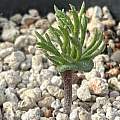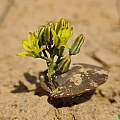Eriospermum is a genus of the family Eriospermaceae, loosely. There is conflicting evidence and certain authors have placed it into the families Ruscaceae, Convallariaceae or the expanded Asparagaceae. The name can be derived from the Greek erion for "wool" and sperma for "seed". Indeed, this is true because the seeds of eriospermums are covered in a dense layer of white hairs. The rootstock is a round or irregularly shaped stem tuber, sometimes producing rhizomes or stolons. The leaves are mostly solitary and usually produced before the flowers, erect to prostrate, hairless or variously hairy. Flowers are small, star or cup-shaped, white to pinkish or greenish or yellow. There are roughly a hundred species of this genus, many of which can be found in winter rainfall regions such as Namaqualand and the Little Karoo, South Africa. In Afrikaans it is called bobbejaanui. Cultivation of the genus depends on whether the species is from the winter or summer rainfall areas. Winter rainfall species should be treated similarly to other geophytic plants of winter rainfall desert areas. A well drained mix is a must and fertilizing them sparingly keeps the plant happy. Seeds should be sown within a year or two. Seedlings should be kept moist throughout their first growing season and given a dose of light fertilizer monthly. They often flower in 3-5 years, depending on the species and growing conditions.
Eriospermum aequilibre Poelln. grows on rocky ground in the succulent eastern Little Karoo. Growing to 50 cm high and flowering in autumn (March-April), it has a single erect blue grey spear-shaped leaf with prominent veins and a narrow stalk that is produced in winter and star-shaped light green to dull yellow flowers tinged brown. Photos from the book Plants of the Klein Karoo courtesy of Jan and Anne Lise Schutte-Vlok.
Eriospermum alcicorne Baker is found on clay and sandstone soils from Namaqualand to the Eastern Cape. Growing to 8 cm high and flowering from late summer to autumn (January to April), this species has a pear-shaped to irregular tuber and white scented flowers with a green line, often tinged red. The erect ovate blue grey leaves, reddish on the underside, appear singly, but more than one can be produced from the tuber. The upper surface of the leaf blade has several leaf-like outgrowths. Leaves are dry at flowering. Photo from the book Plants of the Klein Karoo courtesy of Jan and Anne Lise Schutte-Vlok.
Eriospermum capense (L.) T.M.Salter grows to 50 cm high and is distributed from Namaqualand to the Eastern Cape where it grows mostly on clay soils. The tuber is pear-shaped to irregular. It has one to two heart-shaped green leaves, red underneath, that are erect and spreading and dry at flowering. Flowers are triangular, white to yellow, with a brownish-green line on the petals. Plants flower in summer and autumn (November to March). The leaves are present from April to October. The first two photos from the book Plants of the Klein Karoo are courtesy of Jan and Anne Lise Schutte-Vlok. The last photo of a leaf was taken near Vanrhynsdorp by Alan Horstmann.
Eriospermum cervicorne Marloth comes from central Namaqualand where it grows in granitic sand. This small plant grown by Richard Sullivan was received from Dylan Hannon. It produced its one curious leaf the first year and the following year it flowered with a rather dull white flower. This was promptly devoured by a mouse and I thought the plant was a goner, but this September a new leaf emerged. Height: 8 cm.
Eriospermum cooperi Baker is a summer rainfall species found in rocky grassland and open scrub from the Eastern Cape, South Africa to Zimbabwe. It has a solitary erect leaf and white to pale green flowers and grows to 60 cm. The outer tepals are sometimes reddish brown. Photos from Alessandro Marinello.
Eriospermum corymbosum Baker is a species found in many places in southern Africa (South Africa, Namibia, Botswana). In South Africa it is found in arid areas of the Karoo, Eastern Cape, and the Free State in a variety of habitats. It has a small spherical tuber that is crowned with a dense ring of fine brown fibers, a solitary heart-shaped leaf (3.5 by 2 cm) usually appearing after flowering, and a dense raceme of 6 to 30 pale to bright yellow flowers with a greenish-brown keel. This is a very tiny plant as shown in the pictures taken below in the rain on a rocky outcrop in Andriesberg, Eastern Cape, South Africa, early January 2010. There is a one rand coin to give an idea of how tiny this plant is. Height: about 1-2 cm. We saw a lot of leaves, but only managed to find one plant in bud and none with seed. The first four photos were taken by Bob Rutemoeller. The last two photos from iNaturalist were taken by cliffdorse in the Free State in December and shared under a CC BY-NC license.
Eriospermum crispum P.L.Perry is a rare species found in loamy gravely soils in the Eastern Little Karoo. Plants grow to 35 cm and flower in autumn (March to April). The single erect sword-shaped, leathery leaf has wavy margins and is produced in winter. The flowers are creamy white, star-shaped with a dull green line on the petals and carried on a short stalk in a dense bunch at the top and have a strong carnation scent. Photos and some text from the book Plants of the Klein Karoo courtesy of Jan and Anne Lise Schutte-Vlok.
Eriospermum flabellatum Marloth ex P.L.Perry is a rare species endemic to the Western Little Karoo, growing to 80 cm and found on shale slopes. A single leaf is produced in winter. It is oval with several branched outgrowths. The triangular-shaped white flowers with a green line appear in autumn (March to April) on the top of a short stalk. Photo from the book Plants of the Klein Karoo courtesy of Jan and Anne Lise Schutte-Vlok.
Eriospermum paradoxum (Jacq.) Ker Gawl. is a widespread species distributed from Namaqualand south and east to Grahamstown where it grows in sandy and clay soils. Growing to 10 cm, it has interesting leaves. The single erect leaf usually produced in autumn before the flowers appear in winter (April to May), has many branched hairy, wooly outgrowths. Flowers are white, fragrant, and star-shaped with green or brownish lines on the petals. The first photo from Uluwehi Knecht of a plant he grew. The second photo from the book Plants of the Klein Karoo is courtesy of Jan and Anne Lise Schutte-Vlok. The last photo from Cameron McMaster was taken in Namaqualand.
Eriospermum spp. The first photo below was taken by Nhu Nguyen at the UC Botanical Garden September 2008. It is a summer growing species. The second photo shows the mature "wooly" seeds of an unidentified species. The third photo shows an Amaryllis worm making a meal out of a leaf of an unidentified species. The second and third photos were taken by Cameron McMaster at Cathcart in February 2008.
Keys use the flowers for identification and sometimes the tubers. Since the leaves are usually dry at flowering and often appear after the flower is gone and because there are so many species, it is difficult to identify plants by their leaves when seen in the wild. The photos below from Mary Sue Ittner were taken in different locations in South Africa. The first two photos show plants that were growing sheltered by rocks in the shade at Maclear. There are four species noted in the field guide for the Drakensberg. The second photo could be E. ornithogaloides which is described as having a heart-shaped solitary leaf with red margins fringed with hairs and lying flat on the ground. The third photo was taken near Tulbagh, the fourth in the Komsberg (possibly E. capense which is heart-shaped, often with ridges), and the last at Darling.
Eriospermum zeyheri R.A.Dyer is found in clay soils in renosterveld from the Southwestern to the Southeastern Cape. Growing to 50 cm and flowering summer to autumn (December to March), this species has a white pear-shaped tuber and a prostrate round to heart-shaped leaf. The scented flowers are star-shaped dull white tinged with brown and pink and densely arranged on the top of a short stalk. The first and second photos were taken in Cradock and the third photo at Ecca Pass by Cameron McMaster. The last two photos from the book Plants of the Klein Karoo courtesy of Jan and Anne Lise Schutte-Vlok.



































